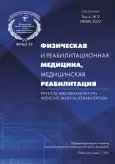Проспективное исследование возможности коррекции различных форм афазий с учетом процессов нейродинамики в речевой реабилитации у пациентов с хроническими повреждениями головного мозга
- Авторы: Харитошкина Е.А.1, Бушуева Е.В.1
-
Учреждения:
- Федеральное государственное бюджетное научное учреждение «Федеральный научно-клинический центр реаниматологии и реабилитологии»
- Выпуск: Том 4, № 2 (2022)
- Страницы: 72-82
- Раздел: ОРИГИНАЛЬНОЕ ИССЛЕДОВАНИЕ
- URL: https://journal-vniispk.ru/2658-6843/article/view/105619
- DOI: https://doi.org/10.36425/rehab105619
- ID: 105619
Цитировать
Полный текст
Аннотация
Обоснование. Актуальность исследования связана с высокой частотой встречаемости и тяжестью речевых дисфункций у пациентов с хроническими повреждениями головного мозга. Синдромальные речевые нарушения, связанные с поражением правого полушария головного мозга, в отличие от левополушарных синдромов, характеризуются размытостью структуры собственно дефекта, меньшей стойкостью к внешним воздействиям, большим объемом нейродинамического компонента, учет которого в реабилитации необходимо рассматривать как фактор, вносящий существенный положительный вклад в достижение результата коррекционно-реабилитационной работы. Комплексная методика коррекционно-реабилитационной работы с данной категорией пациентов, дифференцированная по формам афазии и учитывающая нейродинамические процессы, на сегодня отсутствует, что составляет значительную медико-социальную проблему. Цель исследования — апробация и оценка результативности комплексных методико-методологических подходов в коррекции различных форм афазий с учетом процессов нейродинамики в речевой реабилитации у пациентов с хроническими повреждениями головного мозга. Материал и методы. Обследованы 80 пациентов с различными формами афазий (динамической, семантической, акустико-мнестической), ставшими следствием тяжелых правополушарных повреждений головного мозга, из них 40 пациентов основной и 40 — контрольной группы. Проведена оценка результативности реабилитационной работы на горизонте 6 и 12 мес посредством контроля динамики заболевания. Описаны методы и опыт реабилитационной работы, структурированные по наиболее распространённым формам афазии. Результаты. Показано наличие устойчивых улучшений состояния речевой функции у пациентов с различными формами афазии через 6 и 12 мес от начала реабилитации, включая случаи осложненной динамической афазии. Даны методико-методологические и практические рекомендации по коррекции различных форм афазий с учетом процессов нейродинамики в речевой реабилитации у пациентов с хроническими повреждениями головного мозга, приведены подтверждающие эффективность коррекционно-реабилитационной работы показатели динамики реабилитации пациентов ФНКЦ РР. Заключение. Доказана результативность комплексного подхода к реабилитации пациентов с различными формами афазии с учетом процессов нейродинамики на основе сочетания логопедических занятий, терапевтического вмешательства, мер нейрометаболической поддержки и мероприятий общеукрепляющего характера.
Ключевые слова
Полный текст
Открыть статью на сайте журналаОб авторах
Екатерина Алексеевна Харитошкина
Федеральное государственное бюджетное научное учреждение «Федеральный научно-клинический центр реаниматологии и реабилитологии»
Email: mizpah@list.ru
ORCID iD: 0000-0001-5268-3606
логопед отделения нейрореабилитации
Россия, 141534, Московская область, Солнечногорский район, д. Лыткино, д. 777, корп. 1Елена Викторовна Бушуева
Федеральное государственное бюджетное научное учреждение «Федеральный научно-клинический центр реаниматологии и реабилитологии»
Автор, ответственный за переписку.
Email: bushelenavik@yandex.ru
логопед паллиативно-психиатрического отделения
Россия, 141534, Московская область, Солнечногорский район, д. Лыткино, д. 777, корп. 1Список литературы
- Визель Т.Г., Шабетник О.И. Нарушения высших психических функций и их восстановление при поражениях правого полушария мозга. Москва: Изд. В. Секачев, 2018. 102 с. [Vizel TG, Shabetnik OI. Violations of higher mental functions and their recovery in lesions of the right hemisphere of the brain. Moscow: Publishing house V. Sekachov; 2018. 102 р. (In Russ).]
- Berthier ML. Ten key reasons for continuing research on pharmacotherapy for post-stroke aphasia. Aphasiology. 2021;35(6):824–858. doi: 10.1080/02687038.2020.1769987
- Meinzer M, Elbert T, Wienbruch C, et al. Intensive language training enhances brain plasticity in chronic aphasia. BMC Biology. 2004;2(1):20. doi: 10.1186/1741-7007-2-20
- Thompson CK, den Ouden DB. Neuroimaging and recovery of language in aphasia. Current Neurol Neuroscience Rep. 2008;8(6):475–483. doi: 10.1007/s11910-008-0076-0
- Астаева А.В., Епанешникова Н.В. Нейропсихологическая характеристика нарушений речи при острых нарушениях мозгового кровообращения и проблемы их классификации в отечественной и зарубежной нейропсихологии // Психология. Психофизиология. 2012. № 6. С. 73–79. [Astaeva AV, Epaneshnikova NV. Neuropsychological characteristics of speech disorders in acute disorders of cerebral circulation and problems of their classification in domestic and foreign neuropsychology. Psychology. Psychophysiology. 2012;6(265):73–79. (In Russ).]
- Gorostiza RP, del Castillo FC. Asperger's syndrome and semantical disphasia. Arch De Neurobiol. 1995;58:391–398.
- Damasio AR. Signs of aphasia. Acquired aphasia. 1998;2:27–43.
- Noonan KA, Jefferies E, Corbett F, Ralph MA. Elucidating the nature of deregulated semantic cognition in semantic aphasia: evidence for the roles of prefrontal and temporo-parietal cortices. J Cognitive Neuroscience. 2010;22(7):1597–1613. doi: 10.1162/jocn.2009.21289
- Лурия А.Р. Основы нейропсихологии. Учебное пособие для студентов учреждений высшего профессионального образования, обучающихся по направлению подготовки «Психологии». 8-е изд. Москва: Академия, 2013. 380 с. [Luria AR. Fundamentals of Neuropsychology. A textbook for students of institutions of higher professional education studying in the field of “Psychology”. 8th ed. Moscow: Akademia; 2013. 380 р. (In Russ).]
- Staiger A, Schroeter ML, Ziegler W, et al. Motor speech disorders in the nonfluent, semantic and logopenic variants of primary progressive aphasia. Cortex. 2021;140: 66–79. doi: 10.1016/j.cortex.2021.03.017
- Thye M, Szaflarski JP, Mirman D. Shared lesion correlates of semantic and letter fluency in post‐stroke aphasia. J Neuropsychology. 2021;15(1):143–150. doi: 10.1111/jnp.12211
- Щербакова М.М., Котов С.В. Семантическая афазия. Обследование и реабилитация больных // РМЖ. 2014. Т. 22, № 10. С. 792–794. [Shcherbakova MM, Kotov SV. Semantic aphasia. Examination and rehabilitation of patients. Russian Medical Journal. 2014;22(10):792–794. (In Russ).]
- Антонова Ю.Ю. Характеристика акустико-мнестической афазии и ее отличие от других форм афазии // Евразийский союз ученых. 2018. № 4-5. С. 25–27. [Antonova YY. Characteristics of acoustic-mnestic aphasia and its difference from other forms of aphasia. Eurasian Union Scientists. 2018;(4-5):25–27. (In Russ).]
- Елоева Е.Е. Современные подходы к восстановлению слухоречевой памяти у пациентов с акустико-мнестической афазией // Евразийский союз ученых. 2017. № 4-1. С. 4–6. [Eloeva EE. Modern approaches to the restoration of auditory-speech memory in patients with acoustic-mnestic aphasia. Eurasian Union Scientists. 2017;(4-1):4–6. (In Russ).]
Дополнительные файлы









